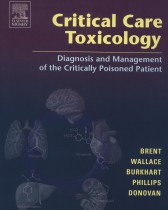|
|
|
| |
 |
|
|

|
 推薦指數:
推薦指數:





|
|
- 內容介紹
|
Critical Care Toxicology - Diagnosis and Management of the Critically Poisoned Patient
By Jeffrey Brent, MD, PhD, Kevin L. Wallace, MD, Keith K Burkhart, MD, FACMT, FACCT, FACEP, Scott D. Phillips, MD, FACP, FACMT and J. Ward Donovan, MD
Approx. 1744 pages, Approx. 600 illustrations (100 in full color), Copyright 2005
Description
Numerous references describe the initial treatment of the acutely poisoned patient; however, this new book is the first major critical care toxicology resource that details patient care from hospital admission and treatment all the way through stabilization, monitoring, and discharge. It presents practical, state-of-the-art treatment recommendations based on initial and subsequent presentation of symptoms, and describes when it's safe to discharge the patient.
Key Features
Individual sections comprehensively cover general management of the critically poisoned patient • toxic syndromes • poisoning by medications • drugs of abuse • chemical agents • biological toxins • agents of chemical and biological terrorism • and antidotes.
Each chapter features the guidance of medical toxicologists who have particular expertise in the area discussed. LI>Coverage includes discussions of the specific clinical concerns involved in treating poisoned pediatric, pregnant, and geriatric patients, as well as general psychiatric issues relevant to the critically poisoned patient.
Table of Contents
Part I. General Management of the Critically Poisoned Patient
1. The Critically Poisoned Patient
2. The Diagnosis of Poisoning
3. Therapeutic Approach to the Critically Poisoned Patient
4. The Role of Toxicology Laboratory Management in the Acutely Poisoned Patient
5. Gastrointestinal Decontamination
6. Charcoal
7. Extracorporeal Removal of Toxic Substances
8. Medical Complications of Poisoning
9. Psychiatric Issues in the Critically Poisoned Patient
10. The Poisoned Pediatric Patient
11. Poisoning in Pregnancy
12. Geriatric Poisoning
13. The Critically Poisoned Worker
14. Complications of Chronic Alcoholism That Impact on Critical Illness
15. Poisoning Fatalities
16. The Treatment of Critically Ill Patients with Hyperbaric Oxygen Therapy
Part II. Toxic Syndromes
17. Hepatotoxic Syndromes
18. Drug-Induced Renal Failure
19. Toxin-Induced Alterations of Consciousness
20. Toxin-Induced Seizures
21. Cardiac Conduction and Rate Disturbances
22. Anticholinergic Syndrome
23. Cholinergic Syndrome
24. Serotonin Syndrome
25. Malignant Syperthermia
26. Neuroleptic Malignant Syndrome
27. Toxic Pulmonary Syndromes
28. Hematologic Syndrome Hemolysis, Methemoglobinemia and Sulfhemoglobeiemia
29. Acid-Base Disorders
30. Withdrawal Syndromes
31. Immunologic Reactions to Drugs, Biological Agents, and Chemicals
32. Sympathomimetric Syndrome
Part III. Medications
Cardiovascular
33. Digitalis Glycosides
34. B-Blockers
35. Calcium Channel Blockers
36. Sodium Channel Blocking Antidysrhythmias
37. Nitroprusside
Decongestant/Antihistaminergic/Bronchodilatory 38. Imidazoline, Guanidine and Oxazoline Antihypertensives and Decongestants
39. Antihistamines
40. Theophylline and Other Methyl Xanthines
41. Sympathomimetic Agents
Psychotropic
42. Cyclic Antidepressants
43. Monomine Oxidase Inhibitors
44. Serotoninergic Antidepressants
45. Poisoning by Neuroleptic Agents
46. Lithium
47. Anxiolytic/Sedative Hypnotics
48. Barbituates
Anticonvulsant
49. Phenytoin
50. Carbamazepine
51. Valproic Acid
Neuromuscular
52. Baclofen
53. Centrally Acting Muscle Relaxants
54. Anti-Parkinson’s Medications
Analgesic/Anti-Inflammatory
55. Acetaminophen (Paracetamol)
56. Opioids
57. Salicylates
58. Nonsteroidal Anti-Inflammatory Agents
59. Gold Compounds
60. Methotrexate
Antimicrobial
61. Isoniazid
62. Rifampin, Dapsone and Vancomycin
63. Chloroquine and Quinine
64. Lactic Acidosis and Nucleoside Analogue Reserve Transcriptase Inhibitors
Hematologic
65. Iron
66. Oral Anticoagulants
67. Parenteral Anticoagulants and Thrombolytics
68. Antitubulins: Colchicine, Podophyllin, Vincristine and Vinblastin
69. Ergot Alkaloids
70. Anti-Diabetic Agents
Part IV. Drugs of Abuse
71. Gamma-Hydroxybutyrate (GHB) and Its Congeners
72. Indole Halllucinogens
73. Amphetamines and Derivatives
74. Poisoning by PCP and Congeners
75. Cocaine Poisoning
Part V. Chemical Agents
76. Arsenic
77. Cadmium
78. Lead
79. Mercury
80. Miscellaneous Metals
81. Phosphorus
82. Thallium
83. Poisoning by Ethylene Glycol and Glycol Ethers
84. Hydrocarbon and Halogenated Hydrocarbons
85. Isoproply Alcohol
86. Methanol and Formaldehyde Poisoning Pesticides
87. Chlorophenoxy Herbicides
88. Fumigants
89. Fungicides
90. Organochlorine Insecticides and Pyrethoids
91. Organophosphorus and Carbamate Insecticide
92. Paraquat and Diquat
93. Rodenticides
Gases and Vapors
94. Carbon Monoxide
95. Cyanide Hydrogen Cyanide, Inorganic Cyanide Salts, and Nitriles
96. Isocyanates and Other Important Chemical Pulmonary Sensitizers
97. Irritant and Toxic Respiratory Injuries
98. Hydrogen Sulfide
Acids and Bases
99. Caustics
100. Hydrofluoric Acid
Part VI. Biological Toxins
101. Overview of Snake Envenoming
102. Rattlesnakes and Other Crotalids
103. North American Coral Snakes and Related Elapids
104. Envenoming by European Snakes
105. Australian and Pacific Snakes
106. Envenomation by Asian Snakes
107. Krait Snakes
108. Envenomation by African Snakes
109. Envenomation by Latin American Snakes
Arthopods
110. Overview of Spider
111. Widow and Related Latrodectus Spider Envenomation
112. Loxoscelism – Envenomation by Loxosceles Spiders
113. Funnel Web Spider Envenomation
114. Scorpion Envenomation
Marine Toxins
115. Poisoning by Marine Vertebrates, Coelenterates and Mollusks
116. Ciguatera Poisoning
117. Scombroid Poisoning
118. Tetrodotoxin Poisoning
Mushrooms
119. An Overview of Mushroom Poisoning
120. Cyclopeptide Containing Mushrooms: The Deadly Aminitas
121. Gyromitra Poisoning
Plants
122. An Overview of Plant and Herbal Toxicity
123. Water Hemlock Poisoning
124. Poison Hemlock
125. Cardiotoxic Plants
126. Anticholinergic Plants
127. Toxalbumins
Miscellaneous
128. Botulism Poisoning
129. Massive Hymenopteran Envenomation
Part VII. Agents of Chemical and Biological Terrorism
130. Chemical and Biological Terrorism Incidents and Intensive Care
Chemical Agents
131. Nerve Agent Poisoning
Biological Agents
132. Anthrax
133. Plague
134a. Smallpox
134b. Encephalitis and Hemorrhagic Fever Viruses
Part VIII. Antidotes
135. Immunotherapy of Poisonings
136. N-Acetylcysteine
137. Opioid Antagonists
138. Flumzanil
139. British Anti-Lewisite
140. Calcium Disodium EDTA
141. Succimer
142. DMPS
143. Deferoxamine
144. Atropine
145. Oximes
146. Bromocriptine
147. Pyridoxine
148. Nitrites
149. Thiosulfate
150. Cyanide Binding Anidotes: Dicobalt Edetate and Hydroxycobalamin
151. Ethanol
152. Fomepizole
153. Physostigmine
154. Anti-Digitalis Fab Fragments
155. Methylene Blue
156. Dantrolene
157. Folic and Folinic Acid
158. Thiamine
159. 4-Diamethylaminopherol (4-DMAP) as Antidote for Poisoning by Cyanide
Appendices
A. FDA Pregnancy Risk Categories
B. Doses of Sympathomimetics
C. Adjustment of Drug Doses in ARF
|
|
|

